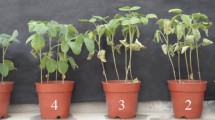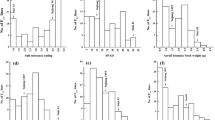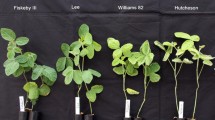Abstract
Salt-affected soils are generally classified into two main categories, sodic (alkaline) and saline. Our previous studies showed that the wild soybean accession JWS156-1 (Glycine soja) from the Kinki area of Japan was tolerant to NaCl salt, and the quantitative trait locus (QTL) for NaCl salt tolerance was located on soybean linkage group N (chromosome 3). Further investigation revealed that the wild soybean accession JWS156-1 also had a higher tolerance to alkaline salt stress. In the present study, an F6 recombinant inbred line mapping population (n = 112) and an F2 population (n = 149) derived from crosses between a cultivated soybean cultivar Jackson and JWS156-1 were used to identify QTL for alkaline salt tolerance in soybean. Evaluation of soybean alkaline salt tolerance was carried out based on salt tolerance rating (STR) and leaf chlorophyll content (SPAD value) after treatment with 180 mM NaHCO3 for about 3 weeks under greenhouse conditions. In both populations, a significant QTL for alkaline salt tolerance was detected on the molecular linkage group D2 (chromosome 17), which accounted for 50.2 and 13.0% of the total variation for STR in the F6 and the F2 populations, respectively. The wild soybean contributed to the tolerance allele in the progenies. Our results suggest that QTL for alkaline salt tolerance is different from the QTL for NaCl salt tolerance found previously in this wild soybean genotype. The DNA markers closely associated with the QTLs might be useful for marker-assisted selection to pyramid tolerance genes in soybean for both alkaline and saline stresses.




Similar content being viewed by others
References
Abel GH (1969) Inheritance of the capacity for chloride inclusion and chloride exclusion by soybeans. Crop Sci 9:697–698
Abel GH, MacKenzie AJ (1964) Salt tolerance of soybean varieties (Glycine max L. Merill) during germination and later growth. Crop Sci 4:157–161
Alcántara E, Romera FJ, de la Guardia MD (1988) Genotypic differences in bicarbonate-induced iron chlorosis in sunflower. J Plant Nutr 11:65–75
Biatczyk J, Lechowski Z, Libik A (1994) Growth of tomato seedlings under different HCO3 − concentration in the medium. J Plant Nutr 17:801–816
Campbell SA, Nishio JN (2000) Iron deficiency studies of sugar beet using an improved sodium bicarbonate-buffered hydroponic growth system. J Plant Nutr 23:741–757
Celik H, Vahap Katkat A (2008) Effects of bicarbonate and iron deprivation on growth of different maize varieties. Am-Euras J Agric Environ Sci 3(2):169–178
Charlson DV, Cianzio SR, Shoemaker RC (2003) Associating SSR markers with soybean resistance to iron deficiency chlorosis. J Plant Nutr 26:2267–2276
Chen H, Cui S, Fu S, Gai J, Yu D (2008) Identification of quantitative trait loci associated with salt tolerance during seedling growth in soybean (Glycine max L.). Aust J Agric Res 59:1086–1091
Concibido VC, Vallee BL, Mclaird P, Pineda N, Meyer J, Hummel L (2003) Introgression of a quantitative trait locus for yield from Glycine soja into commercial soybean cultivars. Theor Appl Genet 106:575–582
Coulombe BA, Chaney RL, Wiebold WJ (1984) Bicarbonate directly induces iron chlorosis in susceptible soybean cultivars. Soil Sci Soc Am J 48:1297–1301
FAO, AGL (2000) Extent and causes of salt affected soils in participating countries (http://www.fao.org/ag/agl/agll/spush/topic2.htm)
Flowers TJ, Flowers SA (2005) Why does salinity pose such a difficult problem for plant breeders? Agric Water Manag 78:15–24
Funatsuki H, Hajika M, Hagihara S, Yamada T, Tanaka Y, Tsuji H, Ishimoto M, Fujino K (2008) Confirmation of the location and the effects of a major QTL controlling pod dehiscence in soybean, qPDH1, in soybean. Breed Sci 58:63–69
Hamwieh A, Xu DH (2008) Conserved salt tolerance quantitative trait locus (QTL) in wild and cultivated soybeans. Breed Sci 58:355–359
Hansen NC, Schmitt MA, Anderson JE, Strock JS (2003) Iron deficiency of soybean in the upper midwest and associated soil properties. Agron J 95:1595–1601
Lee GJ, Boerma HR, Villagarcia MR, Zhou X, Carter TE Jr, Li Z, Gibbs MO (2004) A major QTL conditioning salt tolerance in S-100 soybean and descendent cultivars. Theor Appl Genet 109:1610–1619
Lee JD, Yu JK, Hwang YH, Blake S, So YS, Lee GJ, Nguyen HT, Shannon JG (2008) Genetic diversity of wild soybean (Glycine soja Sieb. and Zucc.) accessions from South Korea and other countries. Crop Sci 48:606–616
Luo Q, Yu B, Liu Y (2005) Differential sensitivity of chloride and sodium ions in seedling of Glycine max and G. soja under NaCl stress. J Plant Physiol 162:1003–1012
Ma HY, Liang ZW (2007) Effect of different soil pH and soil extracts on the germination and seeding growth of Leymus chinensis. Chin Bull Bot 24(2):181–188 (in Chinese with an English abstract)
Millar AL, Rathjen AJ, Cooper DS (2007) Genetic variation for subsoil toxicities in high pH soils. In: Buck HT, Nisi JE, Salomön N (eds) Wheat production in stressed environments. Springer, Dordrecht, pp 395–401
Nichols DM, Lianzheng W, Pei Y, Glover KD, Diers BW (2007) Variability among Chinese Glycine soja and Chinese and North American soybean genotypes. Crop Sci 47:1289–1298
Norvell WA, Adams ML (2006) Screening soybean cultivars for resistance to iron deficiency chlorosis in culture solutions containing magnesium or sodium bicarbonate. J Plant Nutr 29:1855–1867
Rogovska NP, Blackmer AM, Mallarino AP (2007) Relationships between soybean yield, soil pH, and soil carbonate concentration. Soil Sci Soc Am J 71:1251–1256
Sebolt AM, Shoemaker RC, Diers BW (2000) Analysis of a quantitative trait locus allele from wild soybean that increases seed protein concentration in soybean. Crop Sci 40:1438–1444
Song QJ, Marek LF, Shoemaker RC, Lark KG, Concibido VC, Delannay X, Specht JE, Cregan PB (2004) A new integrated genetic linkage map of the soybean. Theor Appl Genet 109:122–128
Van Ooijen JW (2004) MapQTL® 5. Software for the mapping of quantitative trait loci in experimental populations. Kyazma B.V., Wageningen, The Netherlands
Van Ooijen JW (2006) Joinmap® 4.0. Software for calculation of genetic linkage maps in experimental populations. Kyazma B.V., Wageningen, The Netherlands
Wang D, Arelli PR, Shoemaker RC, Diers BW (2001) Loci underlying resistance to race 3 of soybean cyst nematode in Glycine soja plant introduction 468916. Theor Appl Genet 103:561–566
Xu Y, Crouch JH (2008) Marker-assisted selection in plant breeding: from publications to practice. Crop Sci 48:391–407
Xu DH, Gai JY (2003) Genetic diversity of wild and cultivated soybeans growing in China revealed by RAPD analysis. Plant Breed 112:503–506
Xu DH, Abe J, Gai JY, Shimamoto Y (2002) Diversity of chloroplast DNA SSRs in wild and cultivated soybeans: evidence for multiple origins of cultivated soybean. Theor Appl Genet 105:645–653
Yamanaka N, Watanabe S, Toda K, Hayashi M, Fuchigami H, Takahashi R, Harada K (2005) Fine mapping of the FT1 locus for soybean flowering time using a residual heterozygous line derived from a recombinant inbred line. Theor Appl Genet 110:634–639
Yang X, Römheld V, Marschner H (1994) Effect of bicarbonate on root growth and accumulation of organic acids in Zn-inefficient and Zn-efficient rice cultivars (Oryza sativar L.). Plant Soil 164:1–7
Zocchi G, Nisi PD, Dell’Orto M, Espen L, Gallina PM (2007) Iron deficiency differently affects metabolic responses in soybean roots. J Exp Bot 58(5):993–1000
Zuo Y, Zhang F (2008) Effect of peanut mixed cropping with gramineous species on micronutrient concentrations and iron chlorosis of peanut plants grown in a calcareous soil. Plant Soil 306:23–36
Author information
Authors and Affiliations
Corresponding author
Additional information
Communicated by Y. Xue.
Rights and permissions
About this article
Cite this article
Tuyen, D.D., Lal, S.K. & Xu, D.H. Identification of a major QTL allele from wild soybean (Glycine soja Sieb. & Zucc.) for increasing alkaline salt tolerance in soybean. Theor Appl Genet 121, 229–236 (2010). https://doi.org/10.1007/s00122-010-1304-y
Received:
Accepted:
Published:
Issue Date:
DOI: https://doi.org/10.1007/s00122-010-1304-y




